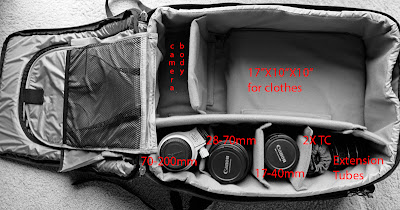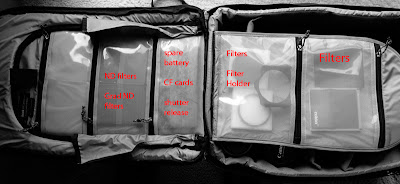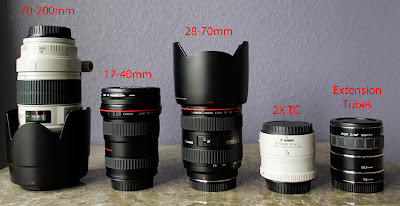The solution that has worked for me is coming up with a “travel kit” of gear that takes up very little space and will cover 99% of anything I ever want or need to shoot. I pack that gear into an “Airport Addicted” backpack made by Thinktank Photo along with most of my clothing. The airport addicted bag was designed to hold the maximum amount of gear possible while still meeting most airline carry-on restrictions. You would be amazed at what I can stuff in this bag and along with my expedition 5 backpack (loaded with the rest of my clothes) carried on as my one “personal item”, I can fit everything I need for a 5 day trip without having to check a single piece of luggage.
When I arrive at my destination, I simply move all the camera gear into my smaller backpack and move all of my clothes into the large one until I’m ready to head back to the airport.
The only down side to this is that the bag can get quite heavy, usually around 40 pounds fully packed, when you have a long way to walk! They have since come out with a “roller” version of this bag and if I traveled a lot more, I would seriously consider getting one.
Now that I’ve covered how I get my gear from here to there, I’ll share what I take and why I feel it’s such a good balance of function and space savings.
99% of what I shoot is between 17-200mm focal length. This includes macro work but a dedicated macro lens is fairly limited so I choose to carry a set of extension tubes to use with my 70-200mm lens. Throw in a 2X tele-converter and that one lens lets me shoot from extreme close-ups all the way out to 400mm. (That in itself is the most practical combination in my line-up.) I then bring a 17-40mm, and a 28-70mm and that’s it! They all share the same filter diameter which cuts down on accessories needed as well. My tripod, with the ballhead removed, attaches to the outside of the bag, my flash cards, spare batteries, and assorted filters are all tucked away in separate zippered compartments inside.
Here are some images of this set-up I quickly shot today while packing for my upcoming workshop in Maine with Kathleen Clemons. We will be driving the coastline of Maine for 4 days, shooting everything from lighthouses to lobsters, and I know that I have all the gear I need for anything that we find along the way.
Ron Goldman
 As you can see, there is plenty of room left for clothes in the main compartment, and there is a laptop compartment on the reverse side as well.
As you can see, there is plenty of room left for clothes in the main compartment, and there is a laptop compartment on the reverse side as well. All of my accessories fit nicely in the top flap compartments.
All of my accessories fit nicely in the top flap compartments. My "travel kit". Small, lightweight, and very functional.
My "travel kit". Small, lightweight, and very functional. Both bags packed and ready to go. My small travel tripod is attached and the ballhead is safely stored away inside.
Both bags packed and ready to go. My small travel tripod is attached and the ballhead is safely stored away inside.

















































